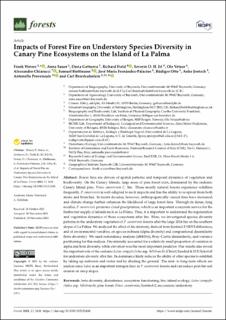| dc.description.abstract | Forest fires are drivers of spatial patterns and temporal dynamics of vegetation and biodiversity. On the Canary Islands, large areas of pine forest exist, dominated by the endemic Canary Island pine, Pinus canariensis C. Sm. These mostly natural forests experience wildfires frequently. P. canariensis is well-adapted to such impacts and has the ability to re-sprout from both stems and branches. In recent decades, however, anthropogenically caused fires have increased, and climate change further enhances the likelihood of large forest fires. Through its dense, long needles, P. canariensis promotes cloud precipitation, which is an important ecosystem service for the freshwater supply of islands such as La Palma. Thus, it is important to understand the regeneration and vegetation dynamics of these ecosystems after fire. Here, we investigated species diversity patterns in the understory vegetation of P. canariensis forests after the large 2016 fire on the southern slopes of La Palma. We analyzed the effect of fire intensity, derived from Sentinel-2 NDVI differences, and of environmental variables, on species richness (alpha diversity) and compositional dissimilarity (beta diversity). We used redundancy analysis (dbRDA), Bray–Curtis dissimilarity, and variance partitioning for this analysis. Fire intensity accounted for a relatively small proportion of variation in alpha and beta diversity, while elevation was the most important predictor. Our results also reveal the important role of the endemic Lotus campylocladus ssp. hillebrandii (Christ) Sandral & D.D.Sokoloff for understory diversity after fire. Its dominance likely reduces the ability of other species to establish by taking up nutrients and water and by shading the ground. The mid- to long-term effects are unclear since Lotus is an important nitrogen fixer in P. canariensis forests and can reduce post-fire soil erosion on steep slopes. | en_US |

